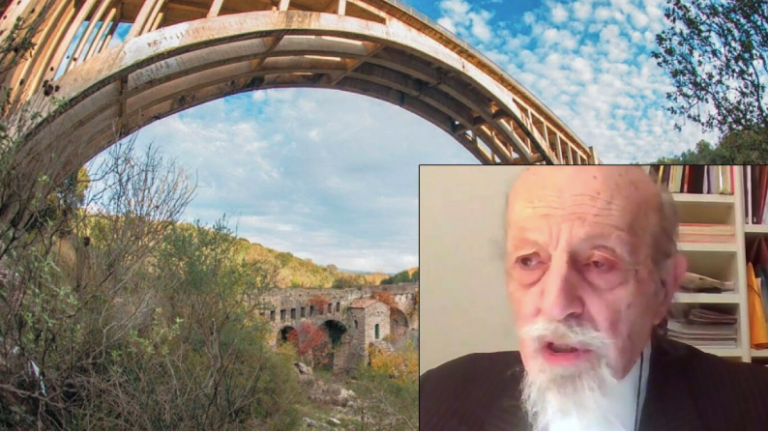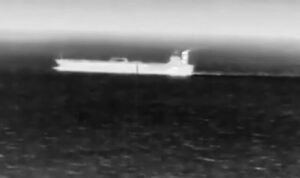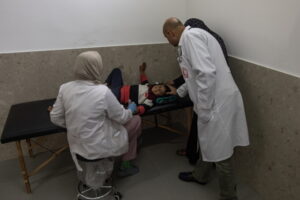In an extraordinary speech, the Emeritus Professor of the NTUA Theodosis Tasios “demolishes” the dangerous bridge of the Alpheus in Karytaina, calling it a corpse and proposing “an urgent meeting of the Ministry of Culture, the Ministry of Infrastructure and the Region” to solve the Gordian knot.
The speech of the professor of the National Technical University of Athens took place in the framework of a symposium on “The complex of bridges in Karytaina-The problem of erosion-The immediate risks-The appropriate solution”, organized by the Association of Karytainians in Athens “Theodoros Kolokotronis” at the National Research Foundation.
The speakers pointed out the tragic coincidence of the one-year anniversary of the Tempi tragedy with the day of the event, which sounds the alarm bell so that we do not mourn other victims through negligence.
They raised the issue of both the erosion and the danger of the new bridge and the danger of the underlying Byzantine bridge with the chapel, the well-known bridge of the pentohiliaros.
The President of the “Theodoros Kolokotronis” Association, which organized the event, Dr. Georgios Adamopoulos and the head of the team that carried out the study for the restoration of the Byzantine bridge, architect-engineer Ioulia Vobiri
The President of the Association, Dr. Georgios Adamopoulos, referred to the history of the construction of the bridge in 1962, described the decision to build the bridge directly over the 800-year-old Byzantine monument as vandalism, and referred to the failures and omissions of the construction.
He also detailed the Association’s long-standing efforts to all the competent authorities on the necessity of taking measures to avoid mourning more Tempi.
This was followed by the presentation of the restoration study of the Byzantine bridge of Pentochiliaros by the architect Ioulia Vobiri, who described in detail the history and the phases of construction of the monument, the damages and the restoration plans of the part that was blown up during the war of 1940.
But the one that won over the large audience was the statement of Professor Theodosios Tasios who “put his finger on the type of the helos”, pointing out that there may be a ready and approved study for the Byzantine bridge, but the debris from the eroded bridge is in danger of damaging the reconstructed monument.
The drilling rig sets to work on the deposits of Crete
Dr C. Adamopoulos closed his speech by referring to the study that was funded by the Region and in which there is a clear reference to the inappropriate choice of the point chosen for the construction of the bridge and the preface note where it is pointed out that the demolition of the existing bridge is the right solution but in the absence of money it is proposed to support it with iron structures.
¨Due to the unavailability of financial resources that would be required for the complete removal and relocation of the roadway, the designer mentions, – and therefore the location of the bridge – in a position that will not be connected to the archaeologically protected bridge of Karytaina, as well as due to the lack of resources for the complete survey of the structure (reinforcement layout, quality of concrete, investigation of foundations, etc.) the proposed solution is the following¨.
“In my own words, added Mr. Adamopoulos, we have no money, not even for the studies, let’s do something to prevent the evil and remove our own responsibility! Let us support it!
And happily the proposal of shoring is going ahead, without any study of the enormous pathologies of the bridge. It is not really a solution to the problem.
It is simply a heavy-handed ‘scaffolding’, a very expensive temporary measure costing EUR 2 million, which simply removes the risk of immediate collapse and accident temporarily, giving a little time credit and passing the problem on to those who come after us and our children.
The tragic and brutal degradation of the monument’s environment is out of the question’.
The speech of Professor Theodosius Tasios
The following is the full text of the speech of Professor Emeritus of NTUA Theodosius P. Tasios:
“Perhaps we cannot brag about it – but we have in our country this “unthinkable”: on the historic and historical Alpheus, we have a bridge that is about a thousand years old – and we have ridden it with a new bridge that is 60 years old.
First of all, however, we have to show understanding for the socio-economic conditions which made this outrage possible:
Firstly, the economic conditions at the time did not encourage the construction of a new (albeit short) access road to another bridge crossing of the river.
And, secondly, the prevailing values at the time did not allow for the realization of this historical/visual and functional rape that was taking place. But we have inherited this rape to this day – as is often the case with cultural and environmental issues.
“But the evil today is multiplied: While modern traffic demands have increased manifold (in terms of loads and frequency) compared to the 1950s, the concrete bridge is not even able to accommodate those demands. Its obvious and unknown extent of erosion has already made it partially dangerous.
And this year comes the great historic challenge: The Ministry of Culture is ready to restore the historic bridge – while a culturally unacceptable, and functionally dangerous construction is hanging over it…
And please accept my somewhat competent opinion that (from a strategic point of view) the disease of this structure is incurable: on the horizon of a hoped-for life extension of 20 years(?), at most, the costs of detailed interventions on the whole structure will be unacceptably excessive. And, worst of all, they cannot be carried out with construction sites hanging off the bridge. Scaffolding would also be needed, partially supported by the underlying Monument.
A small indication of this literal impasse is a temporary (I wonder how temporary?) proposal by the District’s technical department to put an iron corset under the partially dangerous bridge to support it. And anyone can imagine the exacerbation of the unsightly and unhistorical overall effect.
“Ladies and Gentlemen, I apologize for presenting these ‘dark’ aspects of the situation so far. But today’s:
-Axial concepts
-technical knowledge, and
-financial capabilities,
allow for a simple and clear solution, as the worthy Engineer Encodia of the Technical Department, when he wrote in his conclusions:
“Complete removal and relocation of the roadway and therefore the position of the bridge, in a location that will not be connected to the archaeologically protected bridge of Karytaina”.
The designer noted of course that this solution was not feasible “due to the unavailability of financial resources”. Yesterday, this.
But today, when on the one hand the restoration of the historic bridge is beginning, while on the other hand the new leadership of the Region is considering perhaps the best medium-term solution, we are all invited with our relevant opinions to help the Region and the competent Ministries of Culture and Infrastructure.
Personally, I submit to the discretion of those responsible the opinion that a definitive solution (as briefly described by the Designer) would have the following extremely favourable consequences:
1) Restoration of a very important monumental value
2) Consequential educational and tourist benefits for the area
3) Serving local traffic needs, without restrictions and risks
4) Stability of future conditions, without concerns and unpredictable costs.
Thus, the Byzantine Monument and the new modern and durable bridge will embrace the meaning of the popular saying “anaria-anaria, let us love each other”!
“However, I regret that I cannot end this brief introduction without mentioning another (extremely unpleasant) consequence of the vandalism of the Monument.
Ask me anything
Explore related questions





